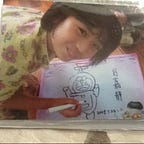Unveiling Shadows of Imperialism: Propaganda, Atrocities, and the Enduring Impact on Historical Truth in Japan’s Nanjing Massacre
This paper discusses the historical context of Japan’s imperialism and colonialism in its neighboring countries, with a particular focus on the atrocities committed, notably during the Nanjing Massacre. The chosen cartoon serves as a poignant representation of Japan’s propaganda during this dark period, vividly illustrating the justifications behind the brutal actions.
The cartoon, likely a Japanese propaganda poster, prominently features slogans like “Peace of East Asian” and “overthrow the Nanjing government.” Visually, it depicts a Japanese military figure forcefully subduing various individuals, including a couple with a child holding the Manchukuo’s flag, an elderly man with a Japanese flag, and other helpless characters. Symbolism is evident in the cartoon’s composition, with the powerful and robust Japanese military figure representing Japan’s perceived obligation to protect smaller characters, such as the Manchukuo people, against a seemingly smaller and incapable Chinese military figure. This propaganda poster encapsulates a dark period when Japan justified massacres in Nanjing under the guise of pursuing the common good of East Asia. As discussed in this course, such propaganda played a crucial role in Japan’s total war strategy, involving non-state and non-military actors. Examining these historical events is crucial, especially given the potential biases present in educational narratives.
Growing up with a Chinese education deeply rooted in history, the Nanjing Massacre stands out as a profoundly tragic chapter. The Japanese military’s brutality not only manifested through violence but also through strategic manipulation of non-state actors, notably the media. This manipulation aimed not only to justify their actions but also to portray them as a virtuous defense for the Japanese people and Asia against Western invasion. While Japan’s attitude toward Western power has transformed, the belief in its own superiority and the desire for neighboring countries to adopt the Japanese way of governance persist. This sentiment is evident in sources such as “Goodbye Asia,” where Japan views Korea and China as weak and feels a responsibility to rescue other Asian nations from Western control (Fukuzawa, 352; Kawamura, 437).
The irony lies in Japan’s claim to seek a Greater East Asia Co-prosperity Sphere for peace, while their actions, as depicted in the cartoon, involved executing massacres in China, causing the death of innocent civilians. This suggests that Japan may have exploited the idea of a “greater and common good” to expand its power and influence. The power of propaganda is evident, as it serves to justify cruel actions, as seen in Yoshida’s insights on revised textbooks and suppressed dissent (Yoshida, 14). Media and education were utilized as non-state actors to rationalize and justify atrocities, as demonstrated by the imprisonment of a taxi driver who expressed anti-Japanese sentiments (Yoshida, 19). This underscores Japan’s use of these actors to perpetuate a distorted narrative and hide the truth of their cruel actions against innocent people.
In the post-war period, Japan’s transformed attitude towards Western powers is notable, transitioning from admiration and learning to a perceived threat that they sought to distance themselves from. However, the underlying sense of superiority over neighboring countries persisted. The article “Goodbye Asia” explicitly states that Japan considers Korea and China to be weak, asserting that “these two countries cannot survive as independent nations with the onslaught of Western civilization to the East” (Fukuzawa, 352). Japan also sees itself as having a political mission to help various regions in the Greater East Asia Co-prosperity Sphere, which are perceived as quasi-colonies of Europe and America, in an effort to rescue them from external control (Kawamura, 437).
The cartoon, emblematic of Japan’s imperialistic pursuits, illustrates the paradox of seeking a “Greater East Asia Co-prosperity Sphere” while perpetrating atrocities in the name of peace. It reveals the deceptive nature of Japan’s propaganda machine, which not only justified cruel actions but actively rewrote history to fit a distorted narrative. The unsettling reality of using media and education to endorse a morally bankrupt narrative becomes apparent. Dissenting Japanese voices were suppressed, perpetuating a distorted narrative that went beyond education. For instance, the imprisonment of a taxi driver for expressing anti-Japanese sentiments reveals the lengths to which Japan went to control the narrative and silence dissent (Yoshida, 19).
This manipulation of information and suppression of dissent had lasting consequences, leaving an enduring scar on both historical truth and collective understanding. Beyond education, the cartoon and other propaganda tools actively contributed to the brutality of the actual massacre by shaping public perception. The use of non-state actors, such as the media, didn’t merely accompany the brutality but actively rewrote history, contributing to the enduring impact on historical truth and collective understanding.
As we grapple with these revelations, the imperative of recognizing faults, facing history, and fostering a nuanced perspective becomes evident. This is not only crucial for modern Japanese society but also for the international community to gain a truthful and just understanding of these events. The cartoon, as a symbol of Japan’s imperialistic past, serves as a reminder of the importance of acknowledging and learning from history to prevent the repetition of such atrocities in the future.
In conclusion, this analysis of the chosen cartoon provides insight into Japan’s imperialism, colonialism, and the atrocities committed during the Nanjing Massacre. The use of propaganda, distorted history, and suppression of dissent had a profound impact on shaping public perception and contributed to the enduring scar on historical truth and collective understanding. Recognizing faults, facing history, and fostering a nuanced perspective are imperative for both modern Japanese society and the international community to gain a truthful and just understanding of these historical events.
Image: https://preview.redd.it/e6oa2oshzzt71.jpg?auto=webp&s=5c61c28b2fe3e62946a3d42602ecf47d2c1560e4
Citations:
Fukuzawa Yukichi, “Goodbye Asia, 1885”
Kawamura Minato, “The Way of Subjects, 1941”
Takashi Yoshida, “Mobilizing the Nation, Sanitizing Aggression”
